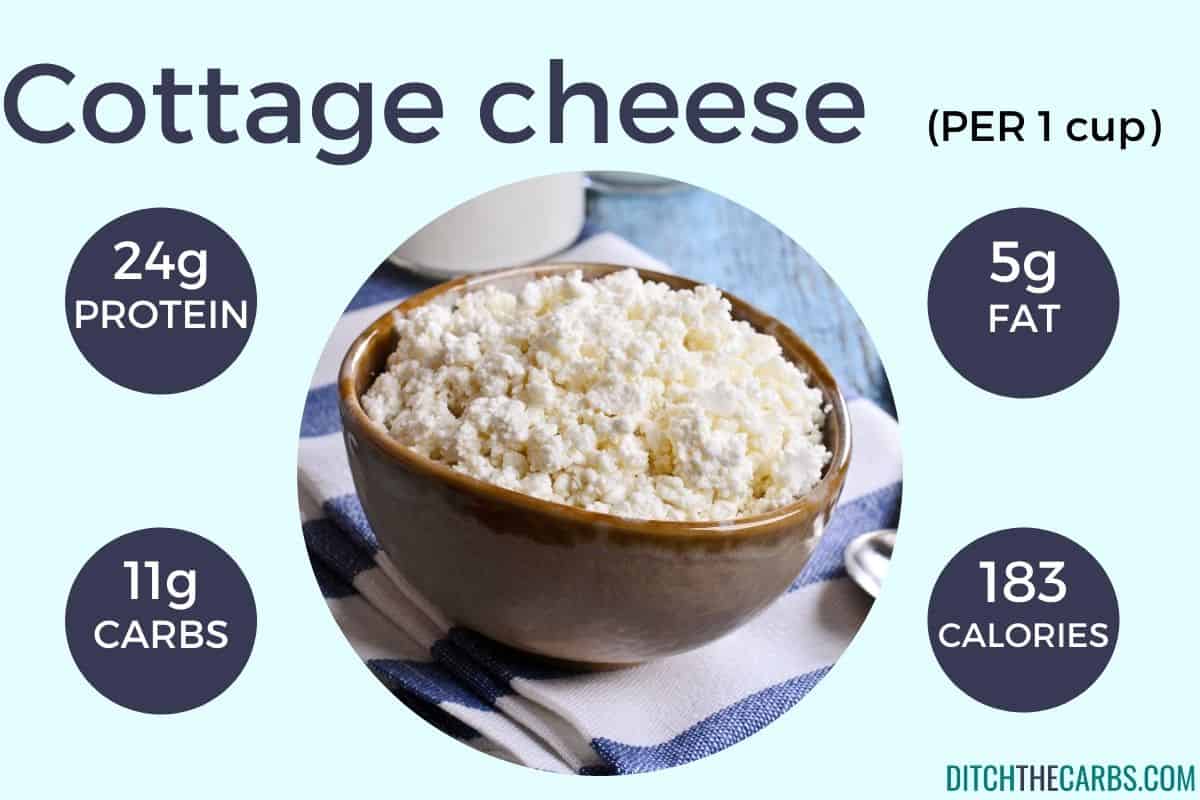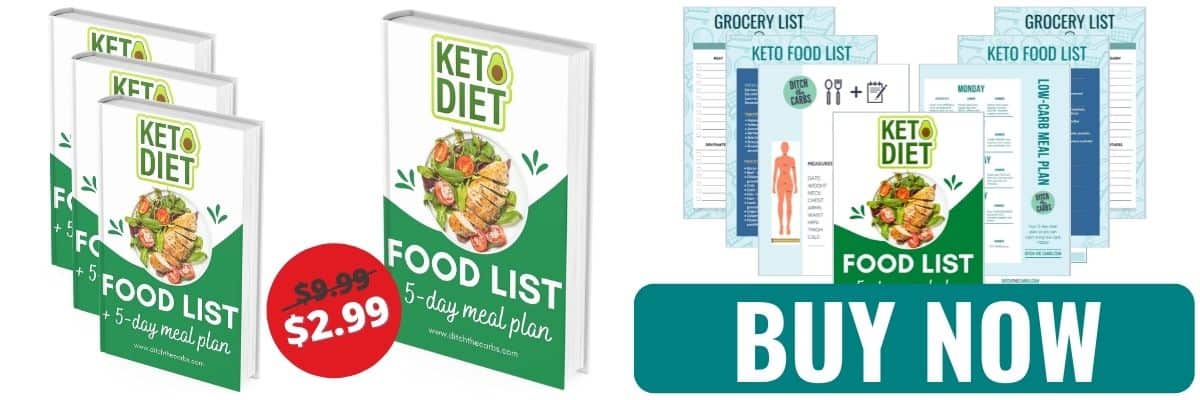Trying to up your protein intake? While most people immediately think of meat protein, dairy protein can be a delicious and versatile way to reach your dietary protein goal!
Yes, cheese and milk contain a surprising amount of protein coupled with a low carb count.

If you want to try the protein-sparing modified fast (PSMF diet), you can download the free printable PDF guidebook, meal plan, PSMF food list, and PSMF calculator.
[convertkit form=3627554]
Are you ready to create the ultimate 12-month blueprint for reaching your health & weight loss goals this coming year?

Our free on-demand video training will walk you through how to make 2024 THE year you set health goals…and keep them.
This ultimate guide will tell you everything you need to know about dairy protein – including which types are the best for you to eat and how to enjoy them.
Dairy nutrition
Besides tasting delicious, dairy sources have a lot of nutrition and health benefits such as protein, calcium, and beneficial bacteria (in cultured dairy).
These foods contain essential amino acids such as leucine, isoleucine, glutamine, phenylalanine, proline, and lysine, just to name a few. (1)
These fancy-sounding branched-chain amino acids help your body regulate blood sugar levels. (2)
Dairy also has bioactive peptides that are said to positively impact human health, including endocrine, cardiovascular, and nervous system benefits. (3)
Like all food groups, each type of dairy food has a different amount of nutrients and dietary protein in it. Keep reading and learn which ones are the highest.
Health benefits of dairy
Increasing protein intake is linked to many health benefits including weight loss and a lower risk for heart disease. There are so many delicious dairy products to choose from, but which is best?
The calcium in dairy is linked to better bone health. Additionally, dairy in milk is also linked to better energy regulation and a lower risk for bone diseases like osteoporosis. (4)
As you care for your health, begin to read nutrition labels. Some types of dairy food will have more satiating fat than others, while some food products might not have the amount of protein you need.
Your protein needs depend on your personal macros, which you can calculate using my free macro calculator.
The good news is that if you need to eat more protein, dairy has essential nutrients and is very easy to add to your meals.
High protein dairy foods

[convertkit form=3627554]
Let’s look at all the different types of food and dairy proteins they have.
Dairy products are wonderful sources of protein, but each type will have a different amount.
There are various types of proteins and each protein will have a unique set of amino acids. Amn acids are the building blocks of protein.
There are 22 amino acids. 9 amino acids cannot be made in the human body and must be obtained from food. These are called essential amino acids.
Whey protein

Nutritional information for 30g of whey protein: 24.5 g protein, 13.9 g net carbs, 0.9 g fat, 124 calories.
Whey protein and casein protein are the two types of milk proteins. Casein is 80% of the protein found in milk. The other 20% of milk protein is whey protein. (5)
Whey protein is a dairy product and you’ll often find it sold as whey protein powder that you can add to food or protein shakes.
There are usually about 25 grams of protein in 2 scoops of powder (which is about 30 grams).
These are the different types of whey proteins:
- Whey Protein Isolate – Processed to remove the fat and lactose. It is usually 90% protein.
- Whey Protein Concentrate – Contains low levels of fat and carbohydrates. They range from 30% to 90% protein.
- Whey Protein Hydrolysate – A predigested form of why protein. It is easiest to digest.
[convertkit form=3627554]
Milk

Nutritional information for 1 cup of milk: 7.7 g protein, 11.7 g net carbs, 7.9 g fat, 149 calories.
For this type of milk, we are talking about cow’s milk rather than almond, rice, or a non-dairy alternative. Milk proteins have important amino acids in them such as albumin and immunoglobulin.
Milk is considered a full protein because it contains all 9 essential amino acids. (6)
There are 8 grams of protein per cup of milk. This is the same amount in skim milk, low-fat milk, or whole milk. However, those adhering to a keto diet will likely choose to avoid milk as the carb and sugar count are quite high. 1 cup of milk contains 12g of carbs which soon add up, especially if you are drinking milky coffees such as cappuccinos or lattes.
Regular yogurt

Nutritional information for 1 cup of yogurt: 14.2 g protein, 1.9 g net carbs, 3.6 g fat, 105 calories.
There is more protein in yogurt than in milk. One cup of natural unsweetened yogurt has 14 grams of protein.
There are functional benefits of eating yogurt as a snack. The beneficial bacteria help to build strong and resilient gut health which can help with improved immunity and improved mood. The protein will help you build lean muscle mass, which can help you lose weight.
Those adhering to a keto diet may opt to enjoy this very sparingly due to a higher carb count and always choose the natural unsweetened yogurt that has the lowest carb count.
Avoid fruit-based yogurts or chocolate-flavored yogurts which have added and unnecessary sugars.
Greek yogurt

Nutritional information for 1 cup of Greek yogurt: 25 g protein, 8.7 g net carbs, 1 g fat, 145 calories.
The protein content in Greek yogurt is even higher. There are 25 grams of protein in a cup.
Greek yogurt can be enjoyed in many different ways, but one of my favourite is in desserts like this 1-minute keto blueberry cheesecake!
Cottage cheese

Nutritional information for 1 cup of cottage cheese: 23.6 g protein, 10.8 g net carbs, 5.1 g fat, 183 calories.
There is a surprising 24 grams of protein in a cup of cottage cheese. That’s enough protein to help you build lean body mass.
Enjoy it on its own or sprinkled with a few low-carb berries, or spread it across a slice of keto-friendly bread.
[convertkit form=3627554]
Cheese

Nutritional information for 1 cup of diced cheddar cheese: 30.2 g protein, 4.4 g net carbs, 44 g fat, 532 calories.
It’s tough to say how much protein is in cheese since the cheese making process is different and affects this number. Your protein intake also depends on whether you are using shredded, melted, diced, or sliced cheese will affect how much cheese you consume in 1 cup.
Cream cheese only has 2 grams per ounce, but the carb count is quite low. I enjoy this baked smoked salmon roulade with cream cheese. The protein in salmon increases the protein content.
Mozzarella has 6 grams per ounce, and I use this powerhouse ingredient often! Fat head dough is one of the best ways to use mozzarella cheese (just make sure to get the low-moisture variety).
Swiss cheese has 12 grams of protein per ounce. Add it to your favorite burger or sandwich to amp up the protein.
Heavy whipping cream

Nutritional information for 1 fluid cup of heavy whipping cream: 6.8 g protein, 6.5 g net carbs, 85.9 g fat, 809 calories.
There are 7 grams of protein in a cup of heavy whipping cream. If you are looking for a delicious way for the whole family to enjoy this, try these creamed Brussel sprouts. They are addictive!
Ice cream
There is almost no protein in typical ice cream. There are just 2.3 grams of protein in 1/2 cup. Ice cream is mostly sugar.
Need something that will help you get your ice cream fix without the sugar? Give these 25 best low carb ice cream recipes a try!
Other high protein foods


The most important thing is that you eat high-quality proteins because they will give your body the nutrition it needs.
Animal sources of protein are one option, but you can also get protein from plant-based foods like seeds and nuts. Eat food like eggs, seeds, and nuts to amp your intake.
- What is a high-protein low-carb diet?
- Best sources of meat protein
- Best sources of vegetable plant-based protein
- Best high-protein nuts and seeds
- Best high-protein vegetables and high-protein fruits (protein charts)

Frequently asked questions
Here are some questions people often ask about dairy protein. If you don’t see your question in this list, please leave it in the comments.
Yes, there is dairy in protein shakes if they are made with whey. However, you’ll want to be very careful with protein shakes as they are often filled with artificial ingredients and added sugars!
Yes, there is quite a bit of protein found in dairy products. In fact, dairy foods are one of the best ways to get protein in your diet, especially if you are a vegetarian.
Cheddar cheese has the most protein out of all the different types of foods made with dairy. There is over 30 g of protein in 1 cup of diced cheese. But with 44 g of fat and 532 calories, you may want to cut back on how much cheese you consume. Choose low-fat cheese instead to help with weight loss.
Yes, whey protein is a dairy product found in many dairy foods. It is made from cow’s milk and is often sold as whey protein isolate or whey protein concentrate. If you are finding it difficult to get enough protein into your meals, then you may want to add some whey protein shakes into your weekly meal plan.
Dairy foods contain whey proteins and casein proteins. The protein quality is considered to be a complete protein because milk contains all 9 essential amino acids.

Final thoughts
The key takeaways are that dairy food is a form of high-quality protein that can be a beneficial part of your vegetarian diet, low-carb diet, or keto diet.
When you are choosing which food to eat, look at the protein sources. Dairy does contain protein, which is an essential nutrient in a low-carb diet, and helps with weight loss, muscle protein synthesis, and appetite control.
There are lots of nutritional benefits of milk and cheese – like calcium for bone health. It can also be good for your health and help you with gut health, nutrition, satiety, and weight loss.
Remember, how much protein you need depends on your personal macros.
Dairy is a fantastic source of protein and is easy to use in various recipes. However, if you are lactose intolerant, there are other protein sources you can use including meat, nuts, and seeds.

Get our FREE guide to finally fix your metabolism!
Losing weight & getting healthy is never easy, but lately you might feel like it’s suddenly become impossible.
Our Flip the Switch guide will help you clearly understand what’s been going on, as well as exactly what you can do to get your metabolism working again so that you can look and feel your best—it’s easier and more simple than you think!










Hi, I am having a lot of trouble trying to find in between meal snacks, like cakes, biscuits.
I have fruit and vegetables, I am vegetarian and now find that I cannot tolerate grains or wheat.when I eat I feel full, but not satisfied hunger wise, what can I bake or no bake for when hunger suddenly attacks please. Love the info her, but am finding it a bit overwhelming at the moment. Live in Spain, so have difficulty finding things on the shelf to eat.